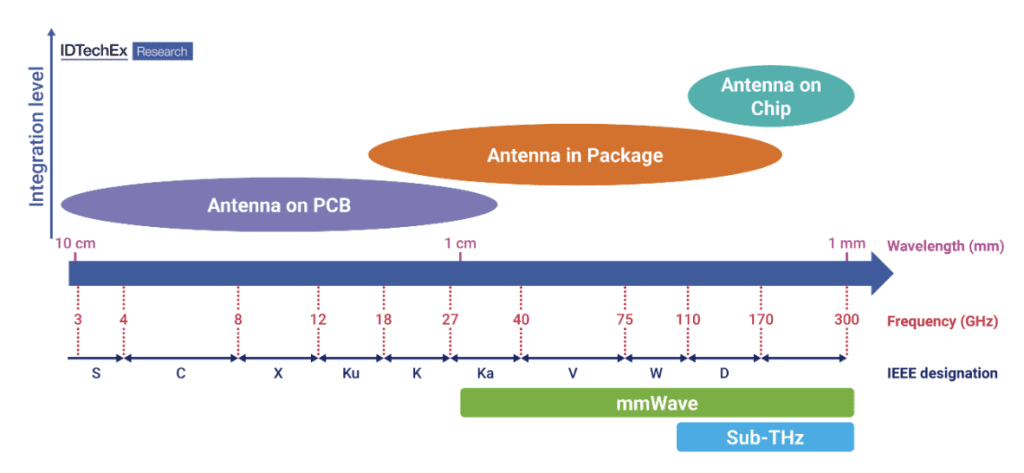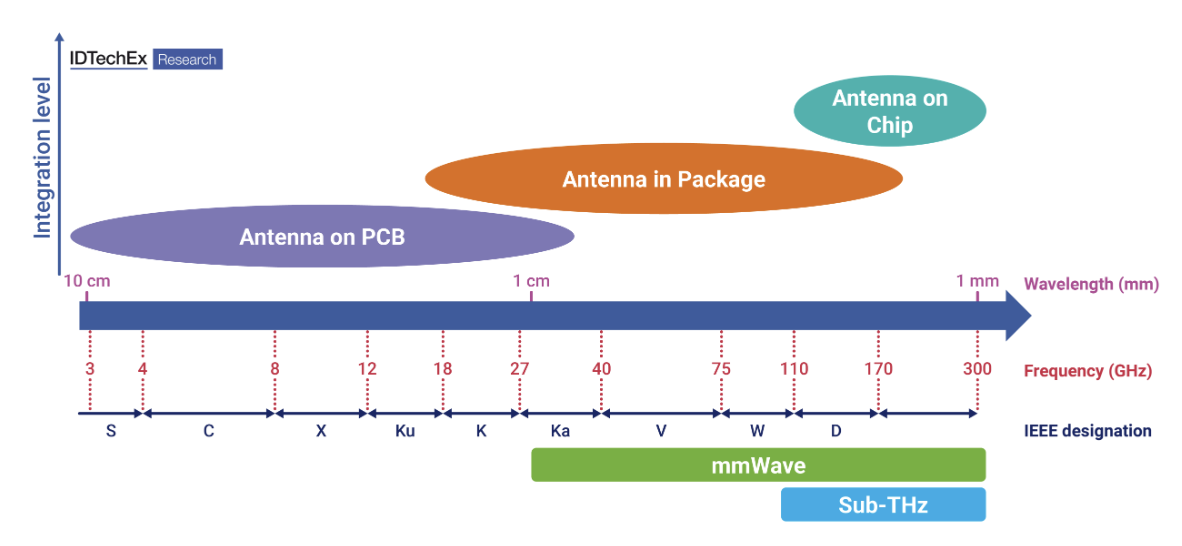By Dr Yu-Han Chang, Senior Technology Analyst at IDTechEx
Millimeter-wave (mmWave), previously confined to military, satellite, and automotive radar applications, has now entered the mobile communications frequency spectrum, offering high data throughput of up to 20 Gbps with an ultralow latency of just 1 ms. This shift necessitates innovative technological advancements across devices, including RF and optical components, low-loss materials, and advanced semiconductor packaging technologies. Among these innovations, packaging stands out as a critical area requiring significant development. It is the key focus of IDTechEx’s brand new report “Antenna in Package (AiP) for 5G and 6G 2024-2034: Technologies, Trends, Markets”.
Antenna-in-package (AiP) represents an advanced antenna packaging technology utilized in high-frequency telecommunications. Leveraging the short wavelengths of mmWave applications, AiP enables the creation of significantly smaller antennas that can be seamlessly integrated directly into semiconductor packages, unlike traditional discrete antennas assembled as individual components on PCB. This integration of the antenna with the transceiver on a single chip offers a host of advantages, including enhanced antenna performance and greatly reduced package footprints. Advancing into the sub-THz range, potentially within the spectrum of 6G, research is underway on new antenna packaging technologies aimed at integrating antennas directly onto RF components. However, this area is still in the research phase due to various manufacturing and scalability challenges.

Key design considerations for AiP
In the development of AiP technology for high-frequency communication devices, cost-effectiveness emerges as the utmost crucial consideration. With a target price of US$2 per 1×1 AiP module, affordability becomes pivotal for widespread adoption, although this presents a chicken-and-egg challenge where adoption must precede cost reduction through economies of scale. Utilizing cost-effective packaging materials and processes is essential. Additionally, miniaturization plays a critical role, especially for integration into consumer devices like smartphones, where component size is paramount. Ensuring that package size can be shrunk while maintaining performance and cost-effectiveness necessitates leveraging new packaging technologies.
Moreover, achieving high performance is vital for AiP platforms. This entails the fabrication and integration of high-gain, broadband mmWave antenna arrays, along with ensuring intra-system electromagnetic compatibility (EMC). Additionally, optimizing equivalent isotropic radiated power (EIRP) and ensuring signal integrity (SI) and power integrity (PI) are crucial aspects. Integrating high-quality factor (Q factor) passives to co-design active mmWave front-end transceiver components further enhances performance. Furthermore, reliability is essential, necessitating a direct thermal passage from the chip to the exterior to dissipate heat from power amplifiers. Scalability adds another layer of versatility, enabling the design of basic modules that can be upscaled to meet various applications with different power requirements. Addressing all these requirements is essential when designing an AiP module for high-frequency communication devices. Questions such as the choice of antenna element, substrate technology, substrate materials, limitations of each substrate technology, integration of passive devices, and supply chain maturity are all explored in IDTechEx’s “Antenna in Package (AiP) for 5G and 6G 2024-2034: Technologies, Trends, Markets” report.
This new IDTechEx report delves into AiP technologies tailored for 5G mmWave and emerging 6G networks. It analyzes substrate technologies, including organic, LTCC, and glass, alongside packaging methods such as flip-chip and fan-out, from material properties to manufacturing feasibility. The report explores antenna integration beyond 100 GHz, offering case studies and addressing prevalent challenges, projecting a future driven by advanced semiconductor packaging solutions.
Key aspects of the report include:
Overview of 5G mmWave Development and 6G Roadmap:
- Explore the status of 5G mmWave development, technology innovation roadmap, key applications, and market outlook.
- Understand the landscape of 6G, including potential spectrum, enabling THz communication technologies, key research and industry activities, roadmap, technical targets, and applications.
Deep Dive into Beamforming Technologies Enabled by Phased Array Antenna for 5G mmWave:
- Compare beamforming technologies of 5G sub-6 vs mmWave.
- Examine phased array technologies, including antenna, semiconductor, and packaging integration components, technical requirements, trends, and design considerations.
Antenna Integration Technologies for 5G mmWave:
- Discuss antenna substrate technology, benchmarking, material requirements, and packaging for phased arrays.
- Explore various antenna packaging technologies for 5G mmWave, including antenna on PCB and antenna in package (AiP), categorized by packaging technologies: Flip-chip vs fan-out. Also, discuss substrate material choices, such as LTCC, low-loss organic-based, and glass, covering production challenges, material choices and benchmarks, solutions/case studies from key players, and substrate design considerations for each packaging technology.
Antenna Integration Technologies for Applications Beyond 100 GHz:
- Address challenges in 6G transceiver development, focusing on power requirements, antenna gain, and phased array demands.
- Discuss various potential packaging technologies for beyond 100 GHz applications, covering thermal management options and low-loss material choices for antenna substrates. Include case studies showcasing D-band (110-170 GHz) phased array technology.
10-year granular market forecast of:
- 5G infrastructure:
- 5G mmWave base station forecast 2023-2034
- Antenna Elements Forecast (Infrastructure)
- AiP for 5G mmWave infrastructure shipment forecast 2023-2034
- AiP for mmWave 5G infrastructure shipment forecast by packaging technology 2024-2034
- mmWave antenna substrate forecast for 5G infrastructure (m2) 2023-2034
- mmWave antenna substrate forecast by material type for 5G infrastructure 2023-2034
- 5G consumer devices: Smartphone and CPE
- AiP module shipment in mmWave compatible smartphone forecast 2023-2034
- AiP module shipment in mmWave-compatible smartphones by packaging technology 2023-2034
- mmWave smartphone antenna area substrate by packaging technology 2023-2034
- 5G mmWave CPE shipment forecast 2023-2034
- 5G CPE mmWave AiP module shipment forecast by packaging technology 2023-2034
- 5G CPE mmWave AiP substrate area forecast by packaging technology 2023-2034
To find out about this brand-new IDTechEx report, including downloadable sample pages, please visit www.IDTechEx.com/AiP.
Upcoming free-to-attend webinar
Exploring Antenna Packaging Technologies: From 5G mmWave to 6G
Dr Yu-Han Chang, Senior Technology Analyst at IDTechEx and author of this article, will be presenting a free-to-attend webinar on the topic on Thursday 14 March 2024 – Exploring Antenna Packaging Technologies: From 5G mmWave to 6G.
This webinar will include:
- An overview of antenna packaging technologies for high frequency telecommunication
- Antenna packaging strategies for mmWave:
- Current status of 5G mmWave
- Antenna packaging technology roadmap
- Case studies
- Market outlook
- Antenna packaging strategies for 6G (beyond 100 GHz)
- Development roadmap for 6G
- Antenna packaging technology roadmap
- Case studies
- Challenges and Solutions
Please click here to check the timings and register for your specific time zone. If you are unable to make the date, please register anyway to receive the links to the on-demand recording (available for a limited time) and webinar slides as soon as they are available.
